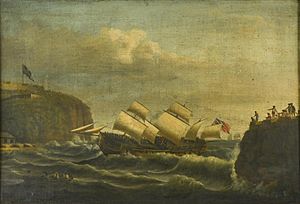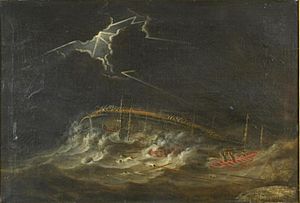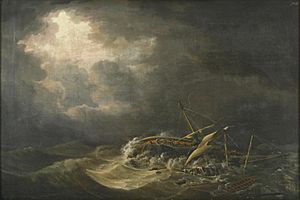HMS Amazon (1773) facts for kids

The Amazon entering the Harbour of St Lucia, a painting by John Thomas Serres
|
|
Quick facts for kids History |
|
|---|---|
| Name | HMS Amazon |
| Ordered | 25 December 1770 |
| Builder | Rotherhithe |
| Laid down | 1771 |
| Launched | 1773 |
| Commissioned | 1777 |
| Fate | Broken up 1794 |
| General characteristics as built | |
| Class and type | 32-gun fifth-rate Amazon-class frigate (1773) frigate |
| Length |
|
| Beam | 35 ft 2 in (10.72 m) |
| Draught |
|
| Depth of hold | 12 ft 2+1⁄2 in (3.721 m) |
| Sail plan | Full-rigged ship |
| Complement | 220 |
| Armament |
|
HMS Amazon was a 32-gun frigate of the Royal Navy, which is like the navy of Great Britain. She was built with 26 main guns and launched in 1773. Her first job was in America, helping with operations around New York.
After returning to England, Amazon served in the English Channel and North Sea. She then sailed to the Leeward Islands where she faced a huge hurricane in 1780. She was part of important battles, like the Battle of Fort Royal in 1781. Later, she was used as a receiving ship (a ship where new sailors would stay) and was eventually taken apart in 1794.
Contents
Building a Warship: HMS Amazon
HMS Amazon was one of the first ships in her class, meaning she was part of a group of similar ships designed by John Williams. She was ordered on December 25, 1770, and her main frame was laid down in April 1771 at the Rotherhithe shipyard.
She was launched on November 2, 1773. Amazon was about 126 feet long along her main deck and could carry a crew of 220 sailors.
What Kind of Guns Did She Have?
Amazon was called a "32-gun fifth-rate" ship. This meant she had 32 main guns. Her main deck had twenty-six 12-pounder guns. These guns fired cannonballs weighing 12 pounds.
She also had smaller 6-pounder guns on her upper decks. Plus, she carried six 18-pounder carronades. Carronades were special short, powerful guns. They were great for close-up fighting because they could fire heavy shots, even though they didn't shoot as far or as accurately as the longer guns.
Amazon's Adventures at Sea
Amazon began her service in February 1776 under Captain Maximillian Jacobs. She sailed to North America in June to join operations near New York. After this, she returned to England in February 1779.
She was then refitted at Chatham. This work included adding copper sheathing to her hull. This copper layer helped protect the ship's wood and made her faster by reducing drag in the water. By July, she was ready for action again.
Facing a Hurricane in the West Indies
In April 1780, Amazon sailed to the West Indies. In October, she was caught in a terrible hurricane near St. Lucia. The storm was so strong that it blew the ship onto its side! Many sailors were trapped below deck, and some were swept overboard.
To save the ship, the crew had to cut down the masts. This helped the ship right itself. Amazon was badly damaged but managed to sail into English Harbour using temporary masts.
Battles and Retreats
Amazon was part of Admiral Hood's fleet in April 1781. They faced the French fleet led by François Joseph Paul de Grasse at the Battle of Fort Royal. Amazon was the first to spot the large enemy fleet and sent a signal to warn Hood.
The French fleet tried to avoid a full battle, but there were several days of smaller fights. At one point, Amazon even towed another ship, Paccahunta, out of danger. However, no clear winner emerged from these encounters.
Later, in May 1781, Amazon was sent to help defend Tobago from a French attack. But when her squadron arrived, the French fleet was already there. The British commander decided not to fight and retreated. By the time the full British fleet arrived, Tobago had already been captured by the French.
End of Service
After more time in the Caribbean and North American waters, Amazon sailed back to England. She arrived in Portsmouth in February 1782 and was taken out of active service.
In 1784, she was moved to Plymouth and prepared to be kept "in ordinary." This means she was stored and not actively used for fighting. In 1791, she served as a receiving ship, a place where new sailors would live before being assigned to a ship. Finally, in June 1794, HMS Amazon was taken apart.
Paintings of Amazon
Captain William Clement Finch, who commanded Amazon during the 1780 hurricane, asked an artist named John Thomas Serres to paint three pictures. These paintings showed the dramatic events the ship went through in the Caribbean, including the hurricane. Finch later became a rear-admiral in the navy.



